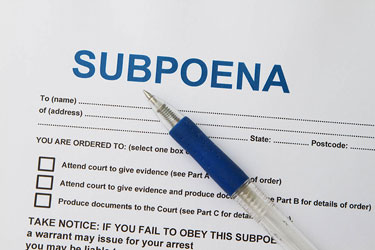
 Working with the U.S. Equal Employment Opportunity Commission (EEOC) can be a balancing act for employers, particularly when one of the agency’s requests seems unreasonable. While companies can and should object to overly broad and burdensome information requests, they also should cooperate to the extent that they can in order to avoid receiving a subpoena.
Working with the U.S. Equal Employment Opportunity Commission (EEOC) can be a balancing act for employers, particularly when one of the agency’s requests seems unreasonable. While companies can and should object to overly broad and burdensome information requests, they also should cooperate to the extent that they can in order to avoid receiving a subpoena.
Objection Options
Companies can object to requests for information on the same grounds that they typically object to discovery requests in litigation—for example, because the request is overbroad, unduly burdensome, costly and/or vague.
Although employers can also object to information requests based on relevance, this objection is usually weak due to the EEOC’s broad investigatory authority, so it’s best to object on another basis when possible.
Similarly, merit-based objections—the claim that the complaint giving rise to the investigation lacks merit—are rarely successful because the EEOC is not required to show at the investigatory stage that there is probable cause to believe that discrimination occurred.
Employers should always object based on privilege if the information sought is protected by attorney-client privilege or the work-product doctrine. These are strong objections that the EEOC rarely—if ever—can overcome.
Cooperate While Objecting
Even when objecting to the scope of requests for information, make sure you provide the EEOC with any information that you think is within the scope of the investigation.
For example, if the EEOC were to seek nationwide data after a former retail salesperson filed a complaint against an employer with retail stores all over the country, the employer has the option to object that the request is overbroad, unduly burdensome and costly. At the same time, it’s a good idea to provide a subset of what was asked for, such as the data from the store in which the charging party worked.
The employer’s attorney should talk with the EEOC investigator, explain the burdens in producing all requested information and offer suggestions for a more manageable scope.
Discrimination laws encourage cooperation and voluntary compliance. If employers cooperate with the EEOC to some degree while also objecting, the EEOC investigator may be less inclined to seek a subpoena.
Moreover, if the EEOC does issue a subpoena, and the employer can demonstrate that it has worked with the agency up to that point and continues to cooperate, it is less likely that the EEOC’s general counsel will ask the courts to enforce the subpoena.
Document, Document, Document
As in virtually all employment matters, documentation is crucial. In particular, keep detailed records about the steps your company has taken to cooperate, the communications (both oral and written) you have had with the EEOC, and the reasonable proposals the employer has made during negotiations related to information requests.
All verbal conversations and agreements should be captured on paper. Sending letters in the mail confirming verbal conversations is a good idea and should ensure that the agreement is reflected in the EEOC’s file.
If You Get Subpoenaed
It is in your company’s best interest to avoid a subpoena. Once the EEOC issues one, your options are limited. Still, employers can object to a subpoena on similar grounds as they can to information requests. To object, the employer must mail a petition to revoke or modify the EEOC subpoena within five days after being served. In some jurisdictions, an employer that fails to file a petition to revoke or modify will be viewed as having waived its right to challenge the subpoena in court.
Responding to a Subpoena Request
When providing information to the EEOC during an investigation, there are various ways an employer can try to avoid a subpoena or, if a subpoena has been issued, prevent it from being enforced. Employers should:
Be reasonable and selective when objecting to EEOC requests for information. Do not object just on grounds of principle, but rather because you have a strong, defensible argument based on the information sought and the scope of the complaint filed.
Pair objections with supplying some information that you concede the EEOC is entitled to receive.
Maintain an ongoing dialogue with the EEOC to ensure that you give the agency information it needs to complete its investigation, but handle responses and the production of information in a way that is manageable for your company.
Keep good records of negotiations with the EEOC during the investigation process, and send paper letters to confirm verbal conversations and agreements.
If an employer does not comply with a subpoena and the EEOC disagrees with the petition to revoke or modify, the EEOC’s general counsel may ask a court to enforce the subpoena. When that happens, courts are highly deferential to the agency. They typically enforce the subpoena as long as the EEOC’s investigation will be conducted for a legitimate purpose and the inquiry is relevant to that purpose, the EEOC does not already have the information, and the agency has followed the required administrative steps.
The EEOC’s subpoena power is not without limits, however. Some courts have declined to enforce overly broad subpoenas.
For example, one court refused to enforce an EEOC request for any information about current or former employees for the previous four years because a pattern or practice investigation was not warranted based on two individuals’ allegations of disability discrimination against only those individuals.
Another court declined to enforce a subpoena to the extent that it sought information related to workplaces other than where the charging party worked, because the EEOC did not show that the allegedly discriminatory policies applied at the other workplaces. In sum, according to the court, although the EEOC has broad subpoena powers, it cannot use them to conduct a “fishing expedition.”
A court may also decline to enforce a subpoena if the employer can demonstrate that complying would be “unduly burdensome.” Basically, an employer must provide evidence demonstrating that compliance would threaten normal business operations.
For instance, in one case when the EEOC sought personnel files from several restaurant locations, the restaurant claimed that managers would have to manually review and copy nearly 18,000 personnel files, requiring approximately 8,925 hours of labor. The court concluded that complying with the subpoena in its original form would be a considerable burden because it would take large amounts of the managers’ time and prevent them from performing their normal duties.
Ultimately, the EEOC agreed to accept a sampling of the files, to inspect and copy the files itself, and to take other measures that decreased the burden on the restaurant. The court concluded that this arrangement would alleviate the burden considerably and ordered the restaurant to produce the files in accordance with the compromise.
The Bottom Line
Even if a request for information and the underlying complaint seem frivolous, always respond in a reasonable manner while delivering information incrementally. Doing so will help ensure the most manageable process possible for both your company and the EEOC.
Cheryl M. Stanton, formerly a shareholder in Ogletree Deakins’ New York City office, is director of the South Carolina Department of Employment and Workforce. Jessica D. Tsuda is an associate in Ogletree Deakins’ Denver office.
Advertisement
An organization run by AI is not a futuristic concept. Such technology is already a part of many workplaces and will continue to shape the labor market and HR. Here's how employers and employees can successfully manage generative AI and other AI-powered systems.
Advertisement


